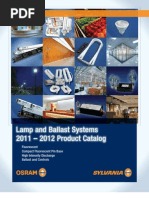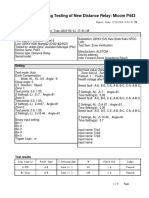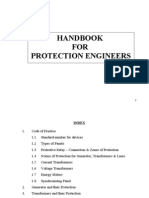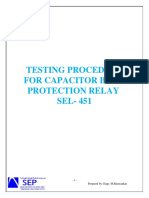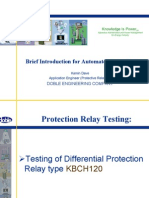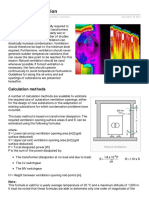CT Saturation
CT Saturation
Uploaded by
Jeya KannanCopyright:
Available Formats
CT Saturation
CT Saturation
Uploaded by
Jeya KannanCopyright
Available Formats
Share this document
Did you find this document useful?
Is this content inappropriate?
Copyright:
Available Formats
CT Saturation
CT Saturation
Uploaded by
Jeya KannanCopyright:
Available Formats
SANKAR NATH
SANKAR NATH S.
TECHNICAL ADVISOR at AL HASOUN AL ARABIA
Upto Knee point, Secondary Current is proportional to Primary Current as per the Current Transformer
Rating. To express in simple way, above Knee point, Secondary current remains more or less same
irrespective of rise of Primary Current which will affect operation of Protective Relay. Saturation level of
Current Transformer is selected as per the Protection system it is meant for.
Shahbaz
Shahbaz H.
International Applications Engineer; Megger
and in saturation region your protection will not work; you should go through CT saturation studies.
virgilio
virgilio R.
Principal Consultant
The knee-point voltage of a current transformer is critical in protective relay application because fault
currents usually range from 20 to 30 times the rated currents of the current transformers. When the knee-
point voltage of a current transformer is reached, the linear
relationship between the primary and secondary currents will no longer apply. Knee-point is defined as
the voltage at which a 10% increase in applied voltage, will increase the magnetizing current by 50%.
These could pose some problems in your relay settings and coordination.
Zeki
Zeki A.
R&D Manager @ ALCE Elektrik San. ve Tic. A.S.
As the esteemed members have explained here is some more in depth info. For protection purposes
there are 5P and 10P transformers according to IEC 61869-1 and IEC 60044-1. However the error values
for 5P and 10P are more. These transformer secondaries almost operate above the saturation (above
Vkp point). For more linear information (reflected to the secondary), that is for better error values,
secondaries are designed with special Vkp, magnetizing current (Im) and Rct values.
The protection scheme engineers usually prefers to use such secondaries for differential protection of
power transformers, generators and/or lines as they are more accurate. When such transformers are
ordered, they are ordered inpairs (for each phase) and their Vkp values are chosen as close as possible.
Antonio
Antonio B.
Director at ABS Representaciones 3533
Lets state in a practical point of view.
In a S/S with a 30 MVA 132/24 KV Transformer & 6 feeders 24 KV have the folowing details:
Rated current for secondary main circuit of this transformer at 24 KV is 722 Amps, so 800/5 TC was
selected. With 5P20 protection class CT, it means that linearity is granted up to 800 x 20= 16 KAmps
Feeders on the other hand are rated for 8 MVA: 192 Amps, 250/5 5 P20 was selected, Linear section is
up to 250 x 20 = 5 KA.
So see the difference?: if you had a 12 KA fault, feeder TC is saturated because 12 KA > 5 KA, providing
false information about actual fault current, whereas Transformers main circuit CT is measuring properly
because 12 KA<16 KA, what happens?, main circuit trips and all 6 feeders get disconnected due to this
bad design (very common).
Solution, if 16 KA is the maximun short circuit expected at that 24 KV busbar, CTs for feeders must at
least 5P64. Other issue is when you have reclosing at feeders and then appears at CT coil remanent flux,
then things gets more complicated, but this is other story . Regards
Rodney
Rodney H.
Managing Director at Rod Hughes Consulting Pty Ltd
Top Contributor
All correct - good example Antonio.
When a CT saturates its current output is zero - hence it will produce some current for the first part of the
first half cycle then suddenly drop to zero for the rest of the first half cycle,
As it recovers from saturation it will again produce some corrent in the second half cycle but then again
suddenly drop to zero.
So what you get is a series of very short positive and negative current spikes in + and - half cycles -
definitely not a 50Hz sinusoid - hence the protection just won't, if at all, work properly.
Therefore protection CTs must be sized to not saturate for the max fault current - as Antonio describes -
this is the max fault current - not just 20 x the rated current of the CT
Zeki
Zeki A.
R&D Manager @ ALCE Elektrik San. ve Tic. A.S.
Please kindly note that in 5P and 10P transformers rather than linearity, % error achieved at accuracy
limit factor.
As per IEC standards the knee point is defined as : when the minimum sinusoidal e.m.f. (r.m.s.) at rated
power frequency is applied to the secondary terminals of the transformer, all other terminals being open-
circuited, which when increased by 10% causes the r.m.s. exciting current to increase by no more than
50%.
With this definition the %error achieved at their accuracy limit factors are above the knee point voltages.
For 5P and 10P transformers, the % errors are, 1% and 3% respectively. Rather than designing a
protection core instead of 5P or 10P requirement, lower error values can be achieved with knee point
specifications requested by the customer.
Philippe
Philippe M.
Consultant elektricity Power at Akka Technologies
Hi all, I would like to add 2 points to the discussion:
1) it is true that class PX CT's can be specified more accurate than the 5P & 10P class P CT's by defining
a very low Imag compared to Isn. The question is wheather it is necessary. I have been responsable to
order these CT's and put them into our transformers and we had requests for CT's over 200kg (>2000
Euro's/piece) becourse the Imag specification was so low that it was hardly possible to produce. We also
received demands for CT's that were physically impossible to produce. I agree that an error of 1% at In is
still large but this would only be the case when the ratio is very low. When you ask for a ratio of 1000/1A I
can guarantee that the error will be less than 0.1% which will be reflected on the test protocol. Indeed,
when the CT's have low ratio's you're in the problem zone anyway. But the standard needs to allow CT's
with low ratio's as well.
2) Antonio has made a nice calculation of the required ALF's for the feeder protections taking into account
the AC RMS part and not the asymmetrical DC part. The problem with the DC part is that it makes your
CT saturate more easely. Im wordt case, The DC offset is so big that the peak value of the current is the
double. Depending on the primary time constant of the system, the DC can be present for more than 10
alternations and may bring your CT core into saturation if the ALF is not chosen much higher than the
actual 100/Uk. I would suggest to take a CT AFL of 3x100/Uk to avoid saturation with wordt case DC
offset during a few periods of time delay before the breaker trips.
Antonio
Antonio B.
Director at ABS Representaciones 3533
Phillip I thank your feedback, you are right. In case of distribution circuits, where there is huge difference
of required settings for TCs we used CT with gaped core for protection, so offset was not a problem,, but
all was against accuracy, again, correct. So we used a dedicated measuring core for protection and
dedicated high accuracy core for metering (today, protections has all in one) is one of the unsolved
questions, good protection goes against measuring accuracy.
In 1981 I was designing for CADAFE, (the biggest Utility in Venezuela atthat time) high accuracy
measuring system for all interfases with genarating Plants & interchange points with other utilities, this
involved more than 40 HV Substations , I arrive to same situation, Ritz Messwandler (in my opinion the
Rolls Royce of CT manufacturers) quoted split core accuracy class 0.3 rated to 150/1 amps to place
outside transformers, around bushings (laying over tank). They were huge and very very expensive. I
prepared everything and resigned to my job at Utility , so I cant assure if they worked as quoted by Ritz,
but is possible to get.
Best regards & Merry Xmas and Happy New year.
Antonio
Rodney
Rodney H.
Managing Director at Rod Hughes Consulting Pty Ltd
Top Contributor
@Phillipe
Accuracy is not the point of defining Ie.
Specifying Ie is about what is the effective primary sensitivity of the protection
If we have a 3ph O/C relay with an E/F in the star pt connected like this:
|-CT-OC-|
|-CT-OC-|
|-CT-OC-|
|---EF----|
Then the effective E/F sensitivity is Iop = (Iefsetting + 3.Ie)
So if we thing we have a 5% relay setting but have 5% Ie, we can suddenly find that the effective E/F pick
up is 20%
Hence even in P class we NEED low Ie for good protection of the power system.
I would therefore prefer to have Ie included in the specification of P class or at least engineers realising
they need to check this in their grading studies.
For PX for differential applications, the inclusion of Ie is not for accuracy of an individual CT at one point
on the curve is not the objective per se.
Ie for Px is about ensuring the dynamic behaviour of the CTs on each end of the diff scheme perform the
same way over the entire B-H curve - we don't care about current accuracy being 1% or 10% but they
must be both inaccurate to the same degree.
Ok - but if that is the case why do we need low Ie for diff PX CTs as long as they are the same?
If we take a Busbar scheme we might have say one incomer and 10 feeders.
for through current conditions incomer = sum feeders
the actual currents that are being compared are therefore
Isecincomer = sum (Isecfeeder)
Ipincomer/Nincomer - Ieincomer = sum (Ipfeeder/N - Iefeeder)
So if Ie too large, we get a huge inherent differential current which as a result of the unbalance of this
equation which would lead to a bus trip possibly even for normal load currents.
More CTs in parrallel for more incomers, bus ties, feeders .... means need to keep Ie lower and lower
(Notre high impedance schemes don't HAVE to be phase-by-phase differential and therefore a single
common diff to all phases would tripple the number of CTs in parrallel so we tend not to do that)
Hence PX specifies the turns ratio not the current ratio with an Ie to ensure they have the same magnetic
core performance on the B-H curve. In fact a significantly lower or higher Ie on one CT would be equally a
problem as this means for a given condition it would give a different output than the others.
P class on the other hand specifies current ratio not turns ratio allows the manufacturer to add or subtract
a turn or two to achieve current ratio accuracy since we want accurate pick up of an OC or EF element .
So small Ie are not (necessarily) protection engineers being annoyingly over-cautious. They are just doing
what they need to do to provide effective protection of the power system given the configuration of the
power system
Philippe
Philippe M.
Consultant elektricity Power at Akka Technologies
Hi Rodney, my conclusion can only be to communicate with each other to work-out a system that is
working perfectly and not unreasonably expensive. We often received CT data when the transformer
design is finished, the production half-way and sometimes the CT's can't be made to fit into the turrets.
Make it happen means to enlarge the turrets & since they are placed exactly at the edge of the tank,
enlarging the tank while the tank is already supplied. It costs 3 month modifications and a tank that can
be scrapped. I guess that not all protection engineers understand the effects of lowering an Ie value of a
CT when it is c critical one.
It was not my arguement to go for the lowest error, that was Zeki's arguement. I think a good
communication is sometimes needed to understand the consequences and a good explanation like yours
helps everybody a big jump in the good direction, thanks for that Rodney.
Rodney
Rodney H.
Managing Director at Rod Hughes Consulting Pty Ltd
Top Contributor
my pleasure - sometimes we assume inherited perceptions are correct but there are (usually) good
reasons.
Large CTs are indeed a real physical problem on bushings or in metalclad switchgear. Solutions - put
them on stanchions or get optical CTs or at least conventional MUs to benefit from IEC 61850 ....
Philippe
Philippe M.
Consultant elektricity Power at Akka Technologies
Starting in transformer controls design, I was a young open minded engineer and most of our clients were
old and narrow minded engineers who were completely against electronics and only mechanical
protection systems they would approve. After a few years I completely understood their doubts about
electronic equipment since each LI or SIL test on the transformer, 50 to 80% of the electronic relays were
distroyed. During these fault conditions, the capasitive couplings, the inductions put extreme elektrical
stresses on the equipment and therefore the electronic relays are removed for dielectrical testing on the
transformer. Indeed, what happens when the lightning really hits the overhead-line and a steep wave is
conducted to the transformer.
Optical CT's offer great solutions for saturation problems, DC offset problems and so on but the
transducers must be kept far from the elektrical polluted environment of the transformer and that makes
them less relyable up to now. A old fashionate CT is rather relyable if you keep the circuit closed. The
relays who are in a safer environment are even programmed to recognise the typical CT faults like
saturation and take this into account to make the old fashioned CT's even more relyable. So I still like
these bulky measuring cores with their imperfections. Once you know them a bit better, you start to like
them as happens on more occasions ....
Rodney
Rodney H.
Managing Director at Rod Hughes Consulting Pty Ltd
Top Contributor
I have visited several substations with optical CTs - the great thing about them is the electronics which
drive the polarised laser beam down the fibre around the busbar and back again CAN be mounted in the
control room!
Just means a fibre per core which has to be a continuos fibre - no patching
But a better solution now electronics and housing have improved is to put the electronics out in the yard
and just run a single or duplicated ethernet network past each Merging Unit with IEC 61850 9-2
In fact if you still like your old CTs you can get te benefit of eliminating hundreds of CT wires per bay
using a conventional CT/VT input Merging Unit https://ideology.atlassian.net/wiki/x/CwBv
Could also replace all the trip/close/status wiring via the same LAN using a little I/O module IEC 61850 8-
1 https://ideology.atlassian.net/wiki/x/mABv
Instant digital substation ..
Then add some other smarts https://ideology.atlassian.net/wiki/x/lABv and you have "5-minute"
equipment failure recovery even at 3am in the morning without the technician leaving home paper
RH19: https://ideology.atlassian.net/wiki/x/HYBq
.. not bad at all eh?!
Chris
Chris W.
Founder at Valence Electrical Training Services LLC
The knee point voltage determines the maximum burden on the CT secondary circuit. For example, if you
have a C400 rated CT, the maximum burden that can be connected to the CT secondary circuit is 4.0
Ohms (400V / 100 A).
If the CT burden for that CT was greater than 4.0 Ohms, the CT may saturate during a fault. When the CT
is saturated, it will not produce proportional current and your relay may not operate because it is not
receiving the correct amount of current.
Antonio
Antonio B.
Director at ABS Representaciones 3533
a hint: as rule of thumb, if you have a CT core rated 5P20 10 VA (IEC) and load it only with the half (5 VA)
the saturation region moves close to the square of the ratio of available burden divided by real burden
(10/5 =2, 2**2=4) around, that means that your CT may become a 5P80 (currently less due to losses in
CT coil) increasing largely CT linear region. This is a trick commonly used i.e. buy a overdimensioned
core for protection use.
This same rule is dangerous for measuring devices, commonly using 5P5, if loaded with less than rated
burden, current wiont start to saturate at 5 times reted current and may damagge current sensors.
Philippe
Philippe M.
Consultant elektricity Power at Akka Technologies
Correct Antonio, only for measuring we use a M5 instead of a 5P5CT. A protection CT has much less
guaranteed accuracy points.
A measuring CT has 2 x 4 points where the accuracy must be within spec and for critical CT's (low ratio)
this is very important.
4 point at rated load: 0.05In, 0.2In, In, 1.2In and the same points for 1/4 of the rated load. This accuracy
can be defined better than 1%
A protection CT has only 2 measuring points at rated load: In (<1%) and ALFIn (<3% for a 5P and <5%
for a 10P)
A mesurement CT with rating 0.5M5 has an accuracy better than:
1.5% @ 0.05In
0.75%@ 0.2In
0.5% @ In
0.5% @ 1.2In
and an instrument security factor 5 meaning that the core has started to saturate ( at least 10% reduction
of output current) at 5 times rated current.
Antonio
Antonio B.
Director at ABS Representaciones 3533
Philippe, sorry, I ment to write 1M5 , 0.5M5 or 0.2M5, 5M5 is not used, at least Ive never seen one.
Philippe
Philippe M.
Consultant elektricity Power at Akka Technologies
No problem, just that nobody get's the idea to use 5P5 for measuring purposes ;-)
Magesh
Magesh G.
SENIOR ELECTRICAL ENGINEER at LTO
If calculated Vk = say 80 volts for 2000/1 Amps CT 5P20 15VA Rct=5 ohms and Rother=1.652 in 33kV
incomer feeder with Sym S.C ct rated at 25kA
then can we use a CT with 400 volts Vk and Im < or = 10mA ?
Using a CT with 600 volt Vk is better or worse than using one with 400 volts Vk ? or is it easier to
manufacture a CT with Vk low like 80 volts than one with 400 volts and above ?
Rodney
Rodney H.
Managing Director at Rod Hughes Consulting Pty Ltd
Top Contributor
Hi Magesh
I'm assuming it is an overcurrent relay application at 33kV.
Ifprimary = 25 kA
CTRatio - 2000/1
means Ifsecondary = 12.5 A
Assuming Rother is the total burden connected to the CT including lead impedance?
the rest is basically Ohm's Law
first looking at the voltage appearing on the terminals of the CT when supplying max fault current into the
connected burden
Vctterminals = Ifsecondary x Rother = 12.5 x 1.652 = 20.65 V
Vctinternal = Vctterminals + (Ifsecondary x Rct) = 20.65 + (12.5 x 5) = 83.5 V
So provided Vkp of CT is > 83.5 V it will not saturate so all OK
the other way to look at this is from the specification itself
when supplying max fault current into the connected burden, the VA is
VAterminals = Vctterminals x Ifsecondary = 20.65 x 12.5 = 258.125 VA
5P20 15VA means it will handle up to 20 x 15 = 300 VA
so to your first question - can you use a CT with Vkp = 400 V?
Depends! What is the Rct of that CT? you need to make sure that:
Vkp > Vctterminals + (Ifsecondary x Rct)
400 > 20.65 + (12.5 x Rct)
i.e. Rct < (400 - 20.65) / 12.5 i.e. Rct < 30 Ohms
I think it is fair to say that most CTs with Vkp = 400 V is most likely to be OK!!
so to second question - is it better or worse?
Higher Vkp means more iron in the cross section of the CT core so its more expensive.
So using a CT with higher than necessary Vkp capability works fine but costs you more than necessary.
third question - is it easier to make a CT with lower Vkp? Yes.
5P20 15VA means that it will handle
Ibrahim
Ibrahim S.
Testing & commissioning Project Manager at alfanar Co.
Really i have enjoyed with that great discussion. but what i think is that
the time is up for the OLD types CTs. Now we have to think for Optical CT
as a much better solution.
Yogesh
Yogesh K.
Executive Manager, Transmission and Distribution, Dar Engineering
I agree with Ibrahim. I liked all above discussion. But it will be more appropriate to start discussion about
optical CTs and how it overcomes saturation problems and all other problems of conventional CTs.
mohamed
mohamed M.
electrical engineer at NLSupervision Company A/S
I think Regwaskey coil CT is overcome the knee point problem of old CT and its error is less than old CT
Frances
Frances T.
MV Engineering Manager at Plummers Industries Pty Ltd
Everything will be slow moving transition from Old type of Ct going to Optical CT due to some factors in
terms market availability and cost between the two specially for small switchboard manufacturing,
electrical suppliers which is critical for them for the total cost of their finished product, especially If they
are participating in any bidding and still they can maintain their compititve cost, the old CT type was
tested and proven in all ages and in very harsh environment that we have in mining industries, and in
other electrical industries in remote areas. Thats how huge the gap that needs to be over came by the
optical CT to prove that it can do much more than what the conventional ct can do. When it comes to
design, it always demand flexibility and reliability in overall application.
For me ot will take awhile for the said transition from conventional to optical CT.
Patrick
Patrick R.
Sr Electrical Engineer at Infigen Energy
Great discussion no marketing and sound engineering applications.
My comment on optical ct's, they are great invention with many applications however it will take time
before their presence in the field increases. Meanwhile we have a lot of ct's installed and we need to
continue to teach those in our field about them and understand how they work.
krishna
krishna R.
HEAD-ELECTRICAL DESIGN at Gracetec Group
I enjoyed the reading very much and thanks for all contributors.esp for antonio for verbal clarity.Simply
superb.
Now about the lead burden.In low voltage 3P&N systems, apart from phase CTs, we have two neutral
CTs, instead of one, one NCT with lead burden same as those for phases and another NCT with longer
control cable length. With this arrangement how to fine tune the knee point voltage requirement. Will the
average lead burden will do?
Comments please.
With regards,
V.Krishna rao
Rodney
Rodney H.
Managing Director at Rod Hughes Consulting Pty Ltd
Top Contributor
"Average" will obviously not do at all!
You need the CTs to be able to produce the maximum voltage for the maximum output current associated
with the maximum burden they are supplying.
You may need to do a few calcs to check each possible scenario of which CT is pushing current through
which burdens.
krishna
krishna R.
HEAD-ELECTRICAL DESIGN at Gracetec Group
Mr.Rodney,
Fantastic!
Very convincing answer!!
Thank you very much.
Regards,
V.Krishna Rao
Meiru
Meiru D.
High Voltage Tester at Siemens
How about a Hall Effect current sensor?
Prabakaran
Prabakaran K.
Electrical Design Engineer at Development Consultant private Limited
Thank you for all...
Adam
Adam H.
Substation Electrical Field Engineer at National Grid
The CT Knee point voltage is directly related to the accuracy range of the CT and the level of current it
can receive before saturation. A CT's accuracy is fairly linear and predictable (useable) until it reaches the
knee point voltage. So our protection CT's must have a high enough knee point voltage to remain
accurate in the expected fault levels of that circuit to enable the correct operation of protection.
At the same time for a metering CT we want this to be accurate in normal operating conditions and
preferably saturate during a fault to prevent any confusing bills, so these would have a much lower knee
point voltage but they are very accurate in the range their designed for.
In basic the knee point defines the range of primary current the CT will remain accurate for.
The relay can only work with what the CT can provide, so its essential to chose the correct class. If you
have chosen the wrong CT class then obviously there could be problems
Rodney
Rodney H.
Managing Director at Rod Hughes Consulting Pty Ltd
Top Contributor
@Adam
that is not totally correct.
Kneepoint is only specified by class PX CTs
Kneepoint and Excitation current is then specified to define the magnetising curve so that we can make
sure that CTs in differential applications - including Restricted Earth Fault differential - all perform the
same way - i.e. having two CTs with the same Excitation current but on ewith a higher VKP means their
slope will be different, or the same VKP but half the excitation current of the other, means that the slopes
will cause a different amount of excitation current for a given voltage requirement, So if the CTs have
different Vkp:Ie ratio, they will create a false differential current.
The next thing then is that VKP and hence class PX has no concern about current accuracy. It only
worries about the same magnetisation performance. You can see this that class PX specifies Winding
Ratio, where as class P specifies current ratio and an accuracy at rated burden and current.
The difference is the Winding Ratio is the exact number of turns
Current ratio means that there may be a different number of turns needed to compensate for the
excitation current in order to achieve a specific accuracy
Kneepoint does not define the range of primary current accuracy since the Excitation current is
dependant on secondary system burden. i.e. even at say half rated current, if the secondary burden,
including the CT winding resistance, means that applying Ohm's Law Ix(Rct + Rburden) is greater than
the CT Vkp, then the CT will saturate, even at less than rated current.
alireza
alireza K.
electrical engineer manager at kwpa
for old generation of the relay protection it's very important to know where is the knee point of the CT's,
because the relay is located in secondary side of the CT's and after CT saturation the relay couldn't
understanding the fault strength.so the relay face to maloperation.but in new version of the relay it's not
important for relay operation(if the relay have CT sat diagnostic).and its still important for CT because in
this cases the ct face with over heating and maybe cause some problem for CT.
Rodney
Rodney H.
Managing Director at Rod Hughes Consulting Pty Ltd
Top Contributor
it is not true that "new version of the relay it's (CT kneepoint voltage) not important for relay operation".
(sorry but I can't read the name of the previous post author)
We must remember that saturation means the CT stops producing current output.
so for the first, say, 2 to 3 milliseconds the output follows the expected sinusoid path, then drops straight
to zero and remaisn there for the rest of that half cycle till it comes back out of saturation. In the next half
cycle something similar happens. It is actually quite complex but imagine the first half cycle like this when
the fault starts
/|___
and then the next half cycle the same but sloping down in the negative direction
\|
Some electromechanical relays - such as high impedance circulating current Merz-Price connection
differential relays - are specifically designed to operate when the CT does saturate like this because the
fault condition is associated with the high impedance path through the relay and will HEAVILY saturate by
design. (Please make sure you have evidence from the manufacturer of electronic HiZ relays being able
to perform in the same way for heavily saturated waveform ... I haven't seen any proof myself yet)
CT saturation detectors will identify this weird saw tooth shape and stabilise the protection to usually NOT
operate because it doesn't have the full sinusoid waveform - ESPECIALLY in numeric relays where they
quite often tend to just work off the 50 Hz component of the waveform.
So please make sure that the CTs are specifically designed not to saturate:
in the case of non-differential applications, P class CTS need to have a capability of supplying the
maximum fault current into the burden at a certain accuracy
i.e.
for P class 1000/5 10VA 5P20 will provide 5% accuracy for 20x 1000A primary with a 10VA rated burden
connected. Note this does not specify the kneepoint point voltage although you can infer the kneepoint
voltage is not less than a derived value.
for PX class with diff applications, we need the CT to be able to drive maximum through fault current
around the CTs path even with one CT saturated based on the formuila
Vkp> 2 x Ifmax x (Rct + Rl)
so a 5A 200/1 0.5PX400 R0.1 means it has EXACTLY 200 turns on the secondary (hence inferring a
nominal but not specific accuracy 1000/5 current ratio) has a kneepoint defined at 400V and 0.5A
excitation current with a CT secondary winding resistance of 0.1ohms
alireza
alireza K.
electrical engineer manager at kwpa
HI,thank you rodney.I really enjoyed when i read your comments.but my article is really about differential
protection and i think my idea its correct even when i read your comments.
Rodney
Rodney H.
Managing Director at Rod Hughes Consulting Pty Ltd
Top Contributor
Hi Alireza
certainly diff protection we tend to use PX CTs so that does mean we are interested in kneepoint voltage.
Modern numerical relays though do not use circulating current connections - each CT has its own input
terminals to the relay so it "looks" more "like" a general P class application in that respect.
We also may have more options to help stabilise the scheme with bias of CT saturation detection, but we
are still really wanting the CTs to perform with the same Vkp-Ie characteristic to minimise false differential
currents so we are still very much interested in Vkp - the slope of a CT with Vkp=400V and Ie=0.05A Ie is
very different to one with 600V/0.02A
alireza
alireza K.
electrical engineer manager at kwpa
HI Rodney
thank you for your attentions.I should tell you all of your comments are true.but my idea say 'when you
use numerical relay with CT sat detection you shouldn't worry about mal-operation of the relay (I do some
tests in ABB factory for proving this about ten years ago).and my friend, my old comments did not tell
us,'we use CT in knee point area for protection' if you read it carefully you can see I didn't recommend it
because of CTs.
You might also like
- Working in The Yard Math 1030Document3 pagesWorking in The Yard Math 1030api-28538206885% (13)
- Design of 132-33kV SSDocument13 pagesDesign of 132-33kV SSSemifallen100% (5)
- Final Configuration Download Procedure For REB500Document10 pagesFinal Configuration Download Procedure For REB500abhigyan100% (1)
- IEC 60255 Electrical RelaysDocument1 pageIEC 60255 Electrical RelaysJeya Kannan20% (5)
- NOJA-7481-00 Application Note - Fault LocatorDocument15 pagesNOJA-7481-00 Application Note - Fault LocatorFranklin Nascimento Viana100% (1)
- MRTPDocument20 pagesMRTPStephen Crawford100% (1)
- Docs Books M-2001B-IB PDFDocument130 pagesDocs Books M-2001B-IB PDFDomingo CordovaNo ratings yet
- Diff6T Stabilized Three-Phase Differential Protection For TransformersDocument48 pagesDiff6T Stabilized Three-Phase Differential Protection For Transformersrajesh100% (1)
- Osram SylvaniaDocument212 pagesOsram SylvaniaAlejandro Márquez100% (1)
- CT Saturation Calculator PDFDocument12 pagesCT Saturation Calculator PDFEBENo ratings yet
- SEL Relays New York Application GuideDocument32 pagesSEL Relays New York Application Guidepistola2No ratings yet
- MVAJ Data Sheet PDFDocument9 pagesMVAJ Data Sheet PDFLynskey1973No ratings yet
- p443 Ksk-Mangla-2 p443 Commissioning Zones ForwaredDocument6 pagesp443 Ksk-Mangla-2 p443 Commissioning Zones ForwaredUmer EhsanNo ratings yet
- Hand Book Revised 1Document269 pagesHand Book Revised 1Neelakandan Masilamani100% (1)
- 7PA22 - Lockout RelayDocument6 pages7PA22 - Lockout RelayJack JohnsonNo ratings yet
- Available Relay ModelsDocument25 pagesAvailable Relay ModelsashokdixitNo ratings yet
- Op Set: Approved Resp Dept Title Rev. Prepared Date Sheet Document No ContDocument8 pagesOp Set: Approved Resp Dept Title Rev. Prepared Date Sheet Document No Contykh92167No ratings yet
- Testing Directional Overcurrent Relays From Valence PDFDocument9 pagesTesting Directional Overcurrent Relays From Valence PDFnaran19794735No ratings yet
- 1MRG008054 en Application Note Function Description For High Impedance Busbar Protection PDFDocument13 pages1MRG008054 en Application Note Function Description For High Impedance Busbar Protection PDFnp_bhuvaneswarNo ratings yet
- CSC 211 ManualDocument48 pagesCSC 211 Manualsgshekar30No ratings yet
- Relay Characteristic AngleDocument14 pagesRelay Characteristic AngleAji Istanto Rambono100% (1)
- 7-How To Test 7sa522Document39 pages7-How To Test 7sa522ahmedNo ratings yet
- 7SG14 - Duobias M Complete Technical Manual PDFDocument142 pages7SG14 - Duobias M Complete Technical Manual PDFhizbi70% (1)
- Auxiliary Units For 7SR23 Catalogue Sheet PDFDocument12 pagesAuxiliary Units For 7SR23 Catalogue Sheet PDFSteven RodriquezNo ratings yet
- 2014 05 PotM Testing CT in Delta Winding ENU PDFDocument9 pages2014 05 PotM Testing CT in Delta Winding ENU PDFYasna SuárezNo ratings yet
- PAC World Magazine - History Protection - Generations of ProtectionDocument7 pagesPAC World Magazine - History Protection - Generations of Protectionb33lawNo ratings yet
- Testing Potential Transformers: by Les Warner (PCA Valence) and Chris Werstiuk (Valence Electrical Training Services LLC)Document11 pagesTesting Potential Transformers: by Les Warner (PCA Valence) and Chris Werstiuk (Valence Electrical Training Services LLC)Avik Poudel100% (1)
- Alf CTDocument9 pagesAlf CTadityahivalkar4141No ratings yet
- Power Swing BlockingDocument4 pagesPower Swing Blockingdetectiveholmes0% (1)
- Test Procedure For Sel 451relaysDocument25 pagesTest Procedure For Sel 451relaysHishamGret100% (1)
- 7SA522 CatalogueDocument53 pages7SA522 Cataloguetayson2002100% (1)
- R8017G MBCHDocument52 pagesR8017G MBCHmjbriceno@gmail.com100% (1)
- CAP 531 1.5 User ManualDocument200 pagesCAP 531 1.5 User ManualmentongNo ratings yet
- Siemens 7SA6x V4.6 Template Manual ENU TU2.22 V1.200Document22 pagesSiemens 7SA6x V4.6 Template Manual ENU TU2.22 V1.200துரைராஜ் இலட்சுமணன்No ratings yet
- Digital Relay Testing Flowchart Valence Electrical Training Services PDFDocument2 pagesDigital Relay Testing Flowchart Valence Electrical Training Services PDFbisas_rishiNo ratings yet
- TRG-10015-2009-V0 - (The Effect of Directional Elements of SEL Relay (32Q and 32V) )Document47 pagesTRG-10015-2009-V0 - (The Effect of Directional Elements of SEL Relay (32Q and 32V) )mendezhandaNo ratings yet
- Template Manual Abb Ret 670 v1.1 Enu Tu2.22 v1.000Document18 pagesTemplate Manual Abb Ret 670 v1.1 Enu Tu2.22 v1.000m_dh87129100% (2)
- Template Manual AREVA P441 P442 P444 E33 ENU TU2.20 V1.000Document17 pagesTemplate Manual AREVA P441 P442 P444 E33 ENU TU2.20 V1.000karthikNo ratings yet
- Power System Protection Testing With The OMICRON Test UniverseDocument1 pagePower System Protection Testing With The OMICRON Test UniversesabrahimaNo ratings yet
- Testing With The State Sequencer Test Module: Practical Example of UseDocument20 pagesTesting With The State Sequencer Test Module: Practical Example of UseAldo Bona HasudunganNo ratings yet
- CMC Ans 11013 EnuDocument27 pagesCMC Ans 11013 EnuWashington MunatsiNo ratings yet
- Fault Recording Webinar PresentationDocument55 pagesFault Recording Webinar Presentationthanh tranNo ratings yet
- Relays Makes Test ProcedureDocument25 pagesRelays Makes Test ProcedureRa HulNo ratings yet
- Polarity Checker User Manua: CPOL - Book Page 1 Thursday, December 13, 2007 10:07 AMDocument10 pagesPolarity Checker User Manua: CPOL - Book Page 1 Thursday, December 13, 2007 10:07 AMLéandre Ettekri NDRINo ratings yet
- 7sd52 7sd62 ConfigurationDocument14 pages7sd52 7sd62 ConfigurationWilber LucasNo ratings yet
- Understanding Permissive UnderDocument7 pagesUnderstanding Permissive UnderJulios Charl Panuncialman TagupaNo ratings yet
- KBCH120 Relay Testing With F6150Document52 pagesKBCH120 Relay Testing With F6150TerezkaM100% (3)
- Micromho Distance Relay For Tanta 220 KvnewfinalDocument15 pagesMicromho Distance Relay For Tanta 220 KvnewfinalMohd SalehNo ratings yet
- Power Swing Blocking Function in Distance RelayDocument6 pagesPower Swing Blocking Function in Distance RelayMahmoud AbuziadNo ratings yet
- Testing Directional Overcurrent Relays: Cheat Sheet: ChecklistDocument2 pagesTesting Directional Overcurrent Relays: Cheat Sheet: Checklistiipmnpti iipmNo ratings yet
- Test Universe Differential Module Application Note Example of Use Transformer ENUDocument16 pagesTest Universe Differential Module Application Note Example of Use Transformer ENUzinab90No ratings yet
- Behaviour of Protection Relays Under CT SaturationDocument2 pagesBehaviour of Protection Relays Under CT Saturationvksharma13100% (1)
- CT Class Very ImportantDocument6 pagesCT Class Very ImportantEngr Fahimuddin QureshiNo ratings yet
- 87 CT Class ExplanationDocument11 pages87 CT Class ExplanationdskymaximusNo ratings yet
- CT 1Document2 pagesCT 1raviNo ratings yet
- Why To Use Class X CTDocument2 pagesWhy To Use Class X CTtwinvbooks100% (1)
- REF ProtectionDocument6 pagesREF ProtectionAshok KumarNo ratings yet
- Current Transformer OperationDocument6 pagesCurrent Transformer Operationsurya892No ratings yet
- differential relayDocument3 pagesdifferential relayEricksen JuliusNo ratings yet
- The Integrating A/D Converter (ICL7135) : Application Note February 1999Document5 pagesThe Integrating A/D Converter (ICL7135) : Application Note February 1999ytnateNo ratings yet
- Ref FerDocument5 pagesRef Feranon_387538941No ratings yet
- CT Saturation in Industrial Applications - : Analysis and Application GuidelinesDocument34 pagesCT Saturation in Industrial Applications - : Analysis and Application GuidelineslrpatraNo ratings yet
- Current TransformersDocument7 pagesCurrent Transformersmn_sundaraamNo ratings yet
- Generator Capability CurveDocument37 pagesGenerator Capability CurveJeya Kannan100% (2)
- Switch Gear and Protection (9085)Document49 pagesSwitch Gear and Protection (9085)Neeraj KumarNo ratings yet
- What Are Relays & How Do They Work PDFDocument8 pagesWhat Are Relays & How Do They Work PDFdeepakNo ratings yet
- 1390497076fault Level Calculation PDFDocument5 pages1390497076fault Level Calculation PDFJeya KannanNo ratings yet
- Power System Protection Studies and Relay CoordinationDocument9 pagesPower System Protection Studies and Relay CoordinationJeya Kannan100% (1)
- Siemens Motor StarterDocument72 pagesSiemens Motor StarterRitesh ChaudharyNo ratings yet
- Busbar Size Calculation (22.8.12)Document16 pagesBusbar Size Calculation (22.8.12)Jeya KannanNo ratings yet
- Fault Level CalculationDocument10 pagesFault Level CalculationJeya Kannan100% (1)
- Provision of Differential RelaysDocument1 pageProvision of Differential RelaysJeya KannanNo ratings yet
- Resistors: Colour Code For Fixed ResistorsDocument2 pagesResistors: Colour Code For Fixed ResistorsJeya KannanNo ratings yet
- Voltage Earth Leakage Circuit BreakerDocument2 pagesVoltage Earth Leakage Circuit BreakerJeya KannanNo ratings yet
- Capacitors in Paralle1Document4 pagesCapacitors in Paralle1Jeya KannanNo ratings yet
- Minutes of CGI Informal Waste Management Thinking Group, 2010Document16 pagesMinutes of CGI Informal Waste Management Thinking Group, 2010virtuallyunboundNo ratings yet
- 20' Refrigerated Container - 2Document4 pages20' Refrigerated Container - 2eddie2166No ratings yet
- Demand Side Management Benefits and Challenges - Goran StrbacDocument8 pagesDemand Side Management Benefits and Challenges - Goran StrbacHamid KhanNo ratings yet
- Adnan Sarfraz-Rotating Equipment EngineerDocument6 pagesAdnan Sarfraz-Rotating Equipment EngineerbillNo ratings yet
- Asian Refining GrowningDocument40 pagesAsian Refining GrowninggustavoemirNo ratings yet
- C&S-Industrial Motor Starter PDFDocument8 pagesC&S-Industrial Motor Starter PDFvijaysatawNo ratings yet
- Improved Efficiency and Reduced Co2Document20 pagesImproved Efficiency and Reduced Co2chrisvakarisNo ratings yet
- Client ListDocument2 pagesClient ListMohamed SameerNo ratings yet
- Stress Analysis of Piping Systems and Pipelines-Harvard UniversityDocument542 pagesStress Analysis of Piping Systems and Pipelines-Harvard UniversityRjeb mohamed100% (3)
- User Manual L336i en V3.22Document123 pagesUser Manual L336i en V3.22Radislav MilankovNo ratings yet
- Turn Your Sink: Into A SpaDocument19 pagesTurn Your Sink: Into A SpaLeo CabelosNo ratings yet
- Lead Mechanical EngineerDocument5 pagesLead Mechanical EngineervcharlesNo ratings yet
- I Energy Weekly Price Update 1680544822Document17 pagesI Energy Weekly Price Update 1680544822PRASANJIT MISHRANo ratings yet
- Thailand FactsheetDocument5 pagesThailand FactsheetNattanapong KongtrakulNo ratings yet
- Nife FlyerDocument2 pagesNife FlyerElnegro NegroNo ratings yet
- 1206 CV - Dineshkumar P - Material ManagementDocument1 page1206 CV - Dineshkumar P - Material Managementkrishnakumar sainathanNo ratings yet
- Technical Catalogue Low Voltage Air Circuit-Breakers: 1SDC200006D0204Document278 pagesTechnical Catalogue Low Voltage Air Circuit-Breakers: 1SDC200006D0204febinjohn100% (1)
- MEP Services PDFDocument1 pageMEP Services PDFmpwasaNo ratings yet
- Alstom Passoni-Villa BushingsDocument4 pagesAlstom Passoni-Villa BushingsSajjad Pirzada0% (1)
- 03-Procedure For WeldingDocument8 pages03-Procedure For WeldingAyush AgarwalNo ratings yet
- Substation Ventilation PDFDocument3 pagesSubstation Ventilation PDFGilberto SanchezNo ratings yet
- Smart City BhopalDocument37 pagesSmart City Bhopalprini priyadharshiniNo ratings yet
- ZZZ2CDC002053D0204 PDFDocument180 pagesZZZ2CDC002053D0204 PDFDaniel StanciuNo ratings yet
- Renovation and Renewing of S.N. Bose Auditorium at IIT Kharagpur. Part - I: Technical BidDocument46 pagesRenovation and Renewing of S.N. Bose Auditorium at IIT Kharagpur. Part - I: Technical BidAssistant Engineer VaikomNo ratings yet
- Lock Out Tag Out Machinery Safety Risk Assessment ChecklistDocument13 pagesLock Out Tag Out Machinery Safety Risk Assessment ChecklistAshish MishraNo ratings yet
- Bloomberg DataDocument203 pagesBloomberg DataSoumya RoutrayNo ratings yet
- General AwarenessDocument137 pagesGeneral AwarenessswamyNo ratings yet
- Fire Risk Assessment Guide - UploadDocument8 pagesFire Risk Assessment Guide - UploadBenson NgNo ratings yet








